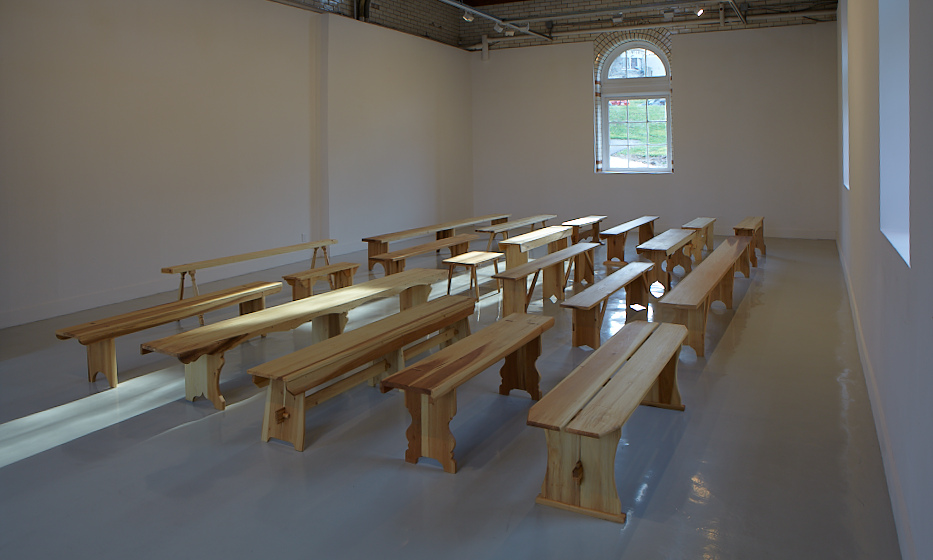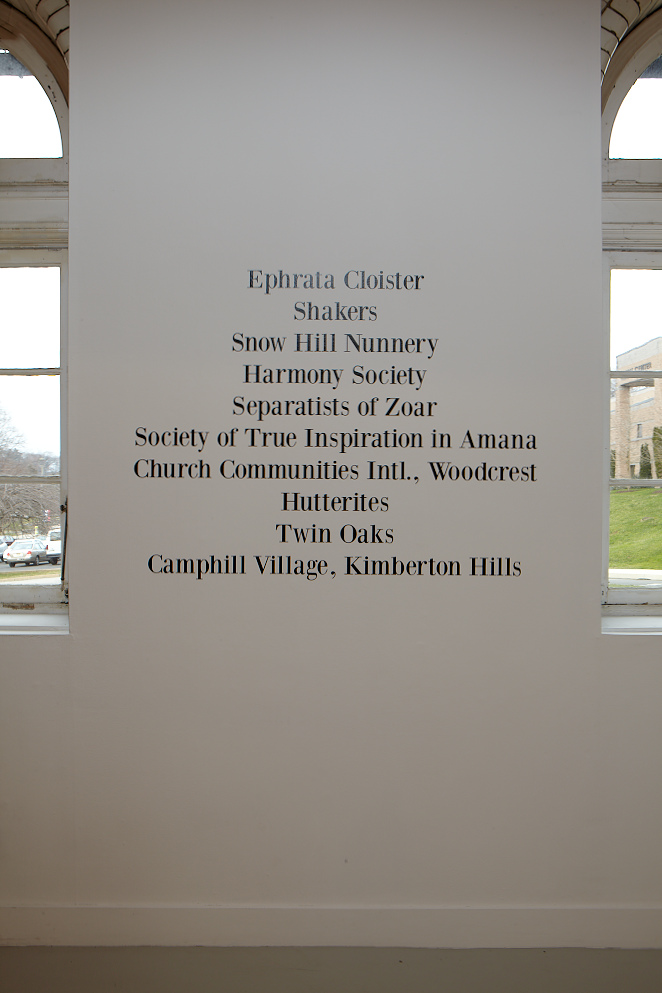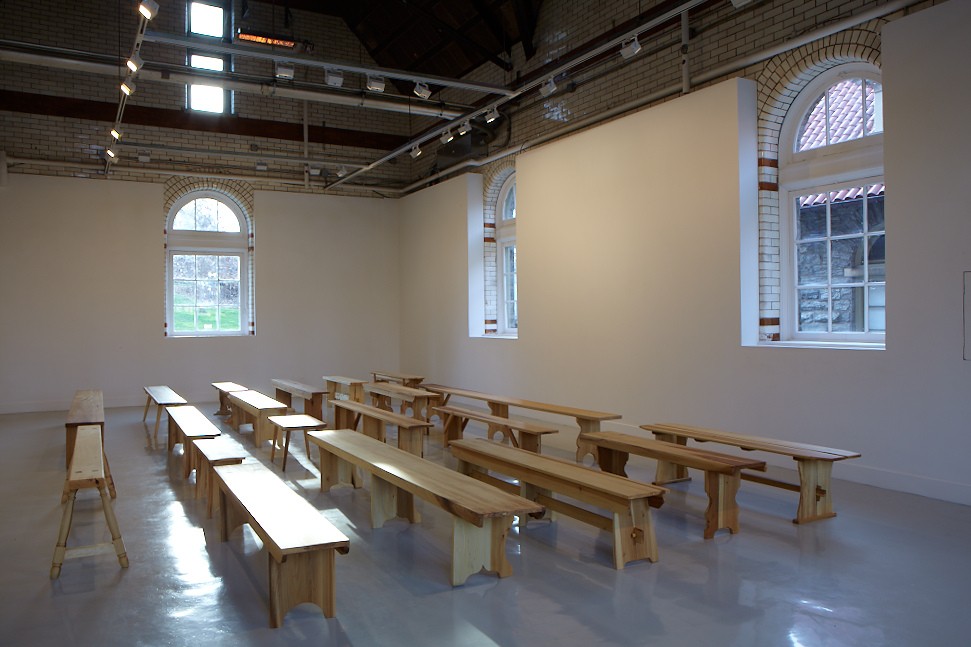November 10, 2011 – January 2, 2012
Arcadia University Art Gallery
Where the installation succeeds most eloquently is in displaying the commonality between furniture and sculpture and the sense of community that can be engendered by something as simple as sharing a bench.
—Edith Newhall
Arcadia University Art Gallery is pleased to announce the opening of Utopian Benches, a new project by the British sculptor Francis Cape. The show, Cape’s first solo exhibition in the Philadelphia area, is comprised of twenty reconstructed benches originally designed for American utopian communities.

Installation view, "Francis Cape: Utopian Benches," 2012, Spruance Gallery, photo: Greenhouse Media
Cape has remade each seat based on a careful study of available examples and measured drawings, many obtained from his own research. Built from poplar grown near Cape’s studio in Narrowsburg, New York, each unpainted bench suggests a newly minted prototype. To be considered both as contemporary sculpture as well as furniture that can be actively used by gallery visitors, the twenty benches evoke the accumulated aspirations that helped to shape them while inviting collective engagement, speculation, and discourse.
The focus of the exhibition is on benches that were designed for 19th-century American utopian communities with a craft tradition, most famously the Shakers, but also the Amana Inspirationists, the Zoar Separatists, and the Harmony Society. In some cases, the examples included were made for use in communal kitchens or feast halls, and in others, for meetings. Cape’s intention is for these benches, as shared seating, to represent community and, as examples of craftsmanship, to propose a reconsideration of value. The project also aspires to address the legacy of resistance to capitalist-driven individualism that formed the founding ideals of American groups once referred to as “communisms” and “socialisms”. As such, the project advocates ways in which an increasingly outmoded category of furniture might be instrumental in exploring the importance of community and collective ownership.
As part of an effort to examine the local as a site of opposition to the global, the exhibition will feature benches from intentional communities within the region of Arcadia University. These range from the Ephrata Cloister (founded in 1732) and Snow Hill Nunnery (Franklin County, founded in 1798) to the contemporary, such as Camphill Village Kimberton Hills (founded in 1972). Sources for the benches are not limited to the region, however, as the craft-focused societies of the Shaker and Amana in America, and the followers of William Morris in the UK exerted a powerful influence on the ethos of furniture makers in both countries.
The benches are arranged in the gallery to face each other as opposed to a dais or altar. With the exception of a list of communities represented by the twenty examples, the walls are left bare to facilitate the transformation of the room into a site of meeting, discussion, and social idealism. To this end, the gallery at Arcadia, housed in a renovated power plant built in 1893, has temporarily revealed and restored three arched windows over which walls were built thirty years ago to facilitate the room’s function as a gallery. Following the closure of the exhibition, the newly exposed windows will disappear again behind the walls.

Installation view, "Francis Cape: Utopian Benches," 2012, Spruance Gallery, photo: Greenhouse Media
Integral to this transformation of the space will be the programming of meetings open to the general public. Following a format established by the Quakers, these gatherings will be focused around a range of topics pertinent to the project, including “utopia”, “the local”, “community”, and “the value of things.” Participants of these meetings will include members of regional communes (who will discuss daily life within their organizations), area craftsmen, as well students and faculty at Arcadia and neighboring institutions. (For more information about these meetings, please visit www.arcadia.edu/gallery.)
Developed as a touring project, “Francis Cape: Utopian Benches” will travel across the United States over the course of the next year and half. Future venues include the Institute of Contemporary Art, Maine College of Art (Portland) and Dwight Hackett projects, (Santa Fe). As such, this new set of sculptures represents a compelling development in the evolution of Cape’s practice, which, for many years has been identified with a rigorous form of site-specificity in which the dimensions of his constructed objects were derived from their presentational contexts and often built directly into them. Apprenticed to a wood carver in England before becoming a sculptor, Cape has made craftsmanship and the history of architectural and furniture design central to his work. His last project focused on the British 1940s Utility Furniture Scheme, a successor to the Arts and Crafts movement there. It was his subsequent research into the American Arts and Crafts and the history of social idealism that led to this project.
Represented in New York City by Murray Guy, Cape has presented his work internationally in solo shows such as “Home Front” at the Anderson Gallery, Virginia Commonwealth University, Richmond, Virginia (2010); Grimm Rosenfeld, Munich (2006); and the St. Louis Art Museum (2004). Recent group exhibitions include “Living Today” at the Glasgow School of Art (2011); and “U.S. Biennial, Prospect 1”, New Orleans, (2008). For his project “The Other End of the Line”, at the High Line, New York (2010), Cape sited a vintage 1972 mobile home under the High Line on Gansevoort Plaza in which he invited Ian Berry, curator of the Tang Teaching Museum, Skidmore College to house a group exhibition. A graduate with an MFA from Goldsmiths College, University of London (1991), Cape is the recipient of a 2001 Louis Comfort Tiffany Award and a Pollock Krasner Grant (2010), among others.

Installation view, "Francis Cape: Utopian Benches," 2012, Spruance Gallery, photo: Greenhouse Media
On Tuesday evening, November 15, Cape will give a slide lecture about his practice and address the evolution of the Utopian Benches. The lecture will begin at 6:30 PM in Room 102 in Brubaker Hall, adjacent to the gallery building. A public reception will follow in the gallery.
The exhibition will be supported by a small, illustrated booklet containing information about each community from which the benches were sourced and available at no charge to visitors.
Gallery Hours: Tuesday, Wednesday 10 a.m. to 5 p.m., Thursday 10 a.m. to 8 p.m., Friday 10 a.m. to 3 p.m., and Weekends noon to 4 p.m., as well as by appointment.
For more information: Contact Arcadia University Art Gallery at 215-572-2131 or 215-572-2133 or visit http://www.arcadia.edu/gallery”www.arcadia.edu/gallery.
Developed as a touring project, “Francis Cape: Utopian Benches” will travel across the United States over the course of the next year and half. Future venues include the Institute of Contemporary Art, Maine College of Art (Portland) and Dwight Hackett projects, (Santa Fe). As such, this new set of sculptures represents a compelling development in the evolution of Cape’s practice, which, for many years has been identified with a rigorous form of site-specificity in which the dimensions of his constructed objects were derived from their presentational contexts and often built directly into them. Apprenticed to a wood carver in England before becoming a sculptor, Cape has made craftsmanship and the history of architectural and furniture design central to his work. His last project focused on the British 1940s Utility Furniture Scheme, a successor to the Arts and Crafts movement there. It was his subsequent research into the American Arts and Crafts and the history of social idealism that led to this project.
Represented in New York City by Murray Guy, Cape has presented his work internationally in solo shows such as “Home Front” at the Anderson Gallery, Virginia Commonwealth University, Richmond, Virginia (2010); Grimm Rosenfeld, Munich (2006); and the St. Louis Art Museum (2004). Recent group exhibitions include “Living Today” at the Glasgow School of Art (2011); and “U.S. Biennial, Prospect 1”, New Orleans, (2008). For his project “The Other End of the Line”, at the High Line, New York (2010), Cape sited a vintage 1972 mobile home under the High Line on Gansevoort Plaza in which he invited Ian Berry, curator of the Tang Teaching Museum, Skidmore College to house a group exhibition. A graduate with an MFA from Goldsmiths College, University of London (1991), Cape is the recipient of a 2001 Louis Comfort Tiffany Award and a Pollock Krasner Grant (2010), among others.
On Tuesday evening, November 15, Cape will give a slide lecture about his practice and address the evolution of the Utopian Benches. The lecture will begin at 6:30 PM in Room 102 in Brubaker Hall, adjacent to the gallery building. A public reception will follow in the gallery.
The exhibition will be supported by a small, illustrated booklet containing information about each community from which the benches were sourced and available at no charge to visitors.
Gallery Hours: Tuesday, Wednesday 10 a.m. to 5 p.m., Thursday 10 a.m. to 8 p.m., Friday 10 a.m. to 3 p.m., and Weekends noon to 4 p.m., as well as by appointment.
For more information: Contact Arcadia University Art Gallery at 215-572-2131 or 215-572-2133 or visit http://www.arcadia.edu/gallery”www.arcadia.edu/gallery.
Artist Lecture
November 15, 2011
Francis Cape will give a slide lecture about his practice and address the evolution of Utopian Benches. The lecture will begin at 6:30 PM in Brubaker Hall, Room 102, adjacent to the gallery building. A public reception will follow in the gallery.
“Wister and More!” presents Ephrata Cloister Chorus
Sunday December 11, 2011, 3 – 5pm
Publications
We Sit on the Same Bench
40-page exhibition booklet about the ten communal societies represented by the furniture in the exhibition, with additional entries about fifteen communal societies sited within a 100-mile radius of Arcadia University and an appendix illustrating each sculpture; texts written by Curatorial Intern Claire Durborow (Class of 2012) and Francis Cape.
“Art with a Cause” review by Roberta Fallon, Philadelphia Daily News, page 42
Friday, December 2, 2011
